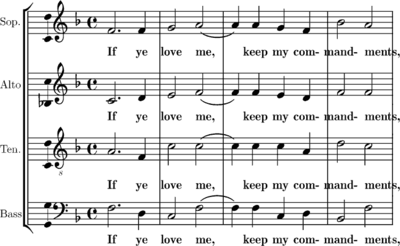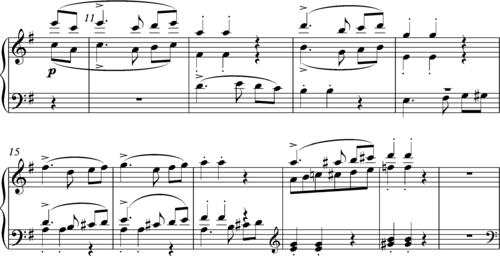Texture (music)
In music, texture is how the tempo, melodic, and harmonic materials are combined in a composition, thus determining the overall quality of the sound in a piece. Texture is often described in regard to the density, or thickness, and range, or width, between lowest and highest pitches, in relative terms as well as more specifically distinguished according to the number of voices, or parts, and the relationship between these voices (see Common types below). For example, a thick texture contains many 'layers' of instruments. One of these layers could be a string section, or another brass. The thickness also is changed by the amount and the richness of the instruments playing the piece. The thickness varies from light to thick. A piece's texture may be changed by the number and character of parts playing at once, the timbre of the instruments or voices playing these parts and the harmony, tempo, and rhythms used (Benward & Saker 2003, ). The types categorized by number and relationship of parts are analyzed and determined through the labeling of primary textural elements: primary melody (PM), secondary melody (SM), parallel supporting melody (PSM), static support (SS), harmonic support (HS), rhythmic support (RS), and harmonic and rhythmic support (HRS) (Isaac & Russell 2003, p. 136).

Common types
In musical terms, particularly in the fields of music history and music analysis, some common terms for different types of texture are:
| Type | Description | Visual | Audio |
|---|---|---|---|
| Monophonic | Monophonic texture includes a single melodic line with no accompaniment. (Benward & Saker 2003, p. 136). PSMs often double or parallel the PM they support (Benward & Saker 2003, p. 137). | ||
| Biphonic | Two distinct lines, the lower sustaining a drone (constant pitch) while the other line creates a more elaborate melody above it. Pedal tones or ostinati would be an example of a SS (Benward & Saker 2003, p. 137). |  Pedal tone in Bach's Prelude no. 6 in D Minor, BWV 851, from The Well Tempered Clavier, Book I, mm. 1–2. All pedal tone notes are consonant except for the last three of the first measure (Benward & Saker 2003, p. 99). |
|
| Polyphonic or Counterpoint or Contrapuntal | Multiple melodic voices which are to a considerable extent independent from or in imitation with one another. Characteristic texture of the Renaissance music, also prevalent during the Baroque period (Benward & Saker 2003, pp. 1999,199,158,137, 136,129,110,90,59,35,11,9,0)). Polyphonic textures may contain several PMs (Benward & Saker 2003, p. 137). |  A bar from J.S. Bach's "Fugue No.17 in A flat", BWV 862, from Das Wohltemperirte Clavier (Part I), a famous example of contrapuntal polyphony. |
|
| Homophonic | The most common texture in Western music: melody and accompaniment. Multiple voices of which one, the melody, stands out prominently and the others form a background of harmonic accompaniment. If all the parts have much the same rhythm, the homophonic texture can also be described as homorhythmic. Characteristic texture of the Classical period and continued to predominate in Romantic music while in the 20th century, "popular music is nearly all homophonic," and, "much of jazz is also" though, "the simultaneous improvisations of some jazz musicians creates a true polyphony" (Benward & Saker 2003, p. 136). Homophonic textures usually contain only one PM (Benward & Saker 2003, p. 137). HS and RS are often combined, thus labeled HRS (Benward & Saker 2003, p. 137). |  Homophony in Tallis' "If Ye Love Me", composed in 1549. The voices move together using the same rhythm, and the relationship between them creates chords: the excerpt begins and ends with an F major triad. |
|
| Homorhythmic | Multiple voices with similar rhythmic material in all parts. Also known as "chordal". May be considered a condition of homophony or distinguished from it. | see above | |
| Heterophonic | Two or more voices simultaneously performing variations of the same melody. |
Many classical pieces feature different kinds of texture within a short space of time. An example is the Scherzo from Schubert’s piano sonata in B major, D575. The first four bars are monophonic, with both hands performing the same melody an octave apart:

Bars 5–10 are homophonic, with all voices coinciding rhythmically:

Bars 11–20 are polyphonic. There are three parts, the top two moving in parallel (interval of a tenth). The lowest part imitates the rhythm of the upper two at the distance of three beats. The passage climaxes abruptly with a bar’s silence:

After the silence, the polyphonic texture expands from three to four independent parts moving simultaneously in bars 21–24. The upper two parts are imitative, the lowest part consists of a repeated note (pedal point) and the remaining part weaves an independent melodic line:

The final four bars revert to homophony, bringing the section to a close;

A complete performance can be heard by following this link: Listen
Additional types
Although in music instruction certain styles or repertoires of music are often identified with one of these descriptions this is basically added music (for example, Gregorian chant is described as monophonic, Bach Chorales are described as homophonic and fugues as polyphonic), many composers use more than one type of texture in the same piece of music.
A simultaneity is more than one complete musical texture occurring at the same time, rather than in succession.
A more recent type of texture first used by György Ligeti is micropolyphony. Other textures include polythematic, polyrhythmic, onomatopoeic, compound, and mixed or composite textures (Corozine 2002, p. 34).
See also
References
- Benward, Bruce, and Marilyn Nadine Saker (2003). Music: In Theory and Practice, seventh edition, vol. 1. Boston: McGraw-Hill. ISBN 978-0-07-294262-0.
- Corozine, Vince (2002). Arranging Music for the Real World: Classical and Commercial Aspects. Pacific, MO: Mel Bay. ISBN 0-7866-4961-5. OCLC 50470629.CS1 maint: ref=harv (link)
- Hanning, Barbara Russano, Concise History of Western Music, based on Donald Jay Grout & Claudia V. Palisca's A History of Western Music, Fifth Edition. Published by W. W. Norton & Company, New York, Copyright 1998. ISBN 0-393-97168-6.
- Isaac, and Russell (2003)..
- Kliewer, Vernon (1975). "Melody: Linear Aspects of Twentieth-Century Music". In Aspects of Twentieth-Century Music, edited by Gary Wittlich, pp. 270–301. Englewood Cliffs, New Jersey: Prentice-Hall. ISBN 0-13-049346-5.
- Kokoras, Panayiotis (2005). Towards a Holophonic Musical Texture. In Proceedings of the ICMC2005 – International Computer Music Conference, . Barcelona: International Computer Music Conference.
Further reading
- Anon.: "Monophony", Grove Music Online, edited by Deane L. Root (accessed 1 August 2015) (subscription required).
- Copland, Aaron. (1957). What to Listen for in Music, revised edition. New York: McGraw-Hill Book Company, Inc.
- Demuth, Norman. 1964. Musical Forms and Textures: A Reference Guide, second edition. London: Barrie and Rockliff.
- Frobenius, Wolf, Peter Cooke, Caroline Bithell, and Izaly Zemtsovsky: "Polyphony', Grove Music Online. edited by Deane Root (accessed 1 August 2015) (subscription required).
- Hyer, Brian: "Homophony", Grove Music Online, edited by Deane Root (accessed 1 August 2015) (subscription required).
- Keys, Ivor. 1961. The Texture of Music: From Purcell to Brahms. London: D. Dobson.
- White, John David. 1995. Theories of Musical Texture in Western History. Perspectives in Music Criticism and Theory 1; Garland Reference Library of the Humanities 1678. New York: Garland Publishers.